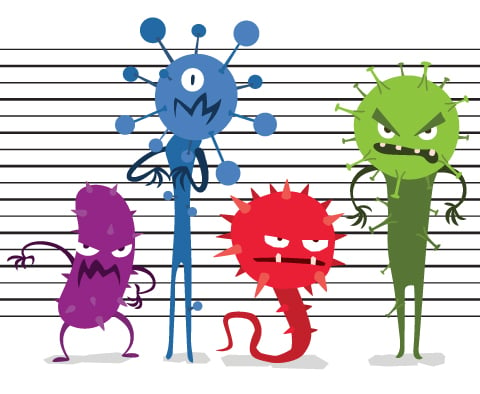UTI (Urinary Tract Infection)
A urinary tract infection (UTI) is an infection in any part of your urinary system – your kidneys, bladder, ureters (the tubes that carry urine from the kidneys to the bladder) or urethra (the tube that carries urine out of the body).
UTIs are usually either "upper" or "lower," depending on where the infection is located. The most common are lower UTIs, which infect the bladder and can cause it to become inflamed (these are referred to as "cystitis").
In most cases, these bladder infections are caused by bacteria, though they can sometimes be caused by certain viruses or fungi (yeast).
Both women and men get bladder infections, but they are much more common among women. For example, among people between the ages of 20 and 50, bacterial UTIs are about 50 times more common among women than men. In people older than 50, there’s less of a difference between the sexes.
Women are susceptible because their urethra is short and close to the vagina and anus. This makes it easier for bacteria to move from one organ to the other. Using a diaphragm with spermicide can also increase the risk of a UTI. In older women, thinning of the tissue around the urethra, which often happens after menopause, may also increase the risk.
Among men, UTIs are often caused by an enlarged prostate or a prostate infection.
Among women and men, anything that blocks the flow of urine – such as a bladder stone – can cause a UTI.
UTI Symptoms
Common UTI symptoms include:
- A persistent urge to urinate
- Pain or burning when urinating
- Very frequent urination
- Straining and dribbling – i.e., passing small amounts of urine
- Blood in the urine (may turn urine red, pink, or brownish)
- Strong-smelling urine
- There may be discharge from the urethra if it becomes infected
- If kidneys become infected, there may also be fever, shakiness, nausea, vomiting, and pain in the side or lower back
MicroGenDX Test Used in Diagnosing UTI
An evaluation and culture (growing microbes from your sample in a lab) are often used to diagnose UTIs. However, standard cultures may come back negative even when you actually do have an infection, and that means your infection won’t be treated. Rather than relying on culture, a MicroGenDX test detects the DNA of all microbes in your sample, along with how much of each is present, and uses that information to identify the bacteria in your infection and the drugs that can best treat it. It is important to know that not all antibiotics work for all bacteria, and some even work differently in different areas of the body. Your doctor should consult the "antimicrobials for consideration" chart on your MicroGenDX report to decide what antibiotic is right for you.
You can order that “UroKEY” test and get complete instructions here:
https://microgendx.com/product/uti-urinalysis-test-service-dm-intl/
Providing a Sample for the UTI Test
You will need to provide a urine sample for this test. It’s very important to obtain a proper sample by following the instructions for collecting the sample, as well as when packaging and shipping it.
Everything you need to know about taking a sample is included in with your test, and is also available online on the product page. The instructions contain illustrations that will help you collect a sample without contaminating it. For example, you will need to wash your hands thoroughly and clean your genital area with soap and water so that bacteria on the skin aren’t included in your sample.
Medical Specialties That Treat UTI
UTIs can be treated by a primary care physician or a urologist.
How UTIs are Treated
Most UTIs are treated by antibiotics. How long and how often you take the antibiotic will depend on which one your doctor prescribes. It is important to complete the full course of medication as it is prescribed, even when symptoms begin to clear up.
If a fungus (yeast) is the cause of your infection, you will be prescribed an anti-fungal.
UTIs often clear up within a few days of beginning treatment, but it’s very important to take the full course of treatment even if symptoms clear up. For example, if an antibiotic is prescribed for five days, take it for the full five days even if your symptoms disappear after three days. The bug that caused the infection might still be in your system even when you no longer have symptoms.
Some bacteria that cause UTIs can develop resistance to specific antibiotics, so that they cannot be effectively treated with those antibiotics. This is why all MicroGenDX diagnostic tests include detection of antibiotic resistance genes in your sample, and then provide alternative antibiotics for your doctor to consider prescribing to you.
Your doctor may also talk with you about other treatments. For example, if your UTI seems to be related to sexual activity, a single dose of an antibiotic after sexual intercourse may be prescribed.
For a very severe UTI, you may need to be treated in a hospital with intravenous antibiotics that are given directly into your vein, and then take a course of oral antibiotics when you return home.
References
- Wagenlehner FME, Cloutier DJ, Komirenko AS, et al: Once-daily plazomicin for complicated urinary tract infections. N Engl J Med 380:729-740,
2019. doi: 10.1056/NEJMoa1801467 - https://www.mayoclinic.org/diseases-conditions/urinary-tract-infection/diagnosis-treatment/drc-20353453
- https://my.clevelandclinic.org/health/diseases/9135-urinary-tract-infections

